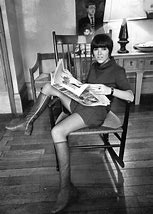
Mary and Plunket Green Quant were both 16 when they joined college and became inseparable. They delighted in pranks and the attention they drew for their outfits.
Mr Plunket Greene once painted his bare chest to mimic the buttons on a dress shirt. Passers-by, Ms Quant recalled in her memoir, sneered, “God, look at this Modern Youth!” a title the pair embraced: “Shall we be Modern Youth tonight?”
They soon met Archie McNair, a lawyer who had become a portrait photographer and who ran a coffee bar under his studio in Chelsea. The three decided to open a business together. Each man put up 5,000 pounds, and they bought a building at 138a King’s Road. Ms Quant, who was working for a milliner, quit her job.
Thanks to Bazaar, King’s Road became the epicentre of British fashion, and London the epicentre of the so-called youthquake, as Vogue put it at the time. Ms Quant was its avatar, garbed in her signature play clothes and boots, with huge painted eyes, a pale face dotted with fake freckles and a distinctive bob that would make its creator, Vidal Sassoon, as famous as she. His wash-and-wear cut was as much a death blow to the laborious bouffant as the miniskirt was to the twin set. “Vidal put the top on it,” Ms. Quant liked to say.
Early on, Ms Quant embraced mass production and synthetic materials and fast fashion that could be bought and discarded, by the young women for whom it was designed.
Captivated by PVC plastic-coated cotton, she made raincoats that seemed slick with water. She made moulded plastic boots in bright colours with clear “ice cube” heels and tops that zipped off.
“Why can’t people see what a machine is capable of doing itself instead of making it copy what the hand does?” Ms Quant told The New York Times Magazine in 1967. “What we should do is take the chemicals and make the fabric direct; we ought to blow clothes the way people blow glass. It’s ridiculous that fabric should be cut up to make a flat thing to go ’round a round person.”
She added, “It’s ridiculous, in this age of machines to continue to make clothes by hand. The most extreme fashion should be very, very cheap. First, because only the young are daring enough to wear it; second, because the young look better in it; and third, because if it’s extreme enough, it shouldn’t last.”
Ms Quant and Mr Plunket Greene married in 1957; he died in 1990. Ms Quant is survived by their son, Orlando Plunket Greene and three grandchildren.
In 2000, Ms Quant stepped down as director of Mary Quant Ltd, having been bought out – or pushed out, as some reports claimed – by the company’s managing director.
In 2009, she was honoured by the Royal Mail with her own postage stamp, featuring a model wearing a black Mary Quant flared mini. In 2015, Ms Quant was made a dame. The storefront once occupied by Bazaar is now a juice bar, above which a plaque now commemorates Dame Mary Quant.
In the spring of 2019, when the Victoria & Albert Museum showed its retrospective of her work, a vibrant exhibition of 120 pieces from her heyday, the curators included a montage of photographs and memories from the thousands of women who had answered their call to share their beloved Mary Quant pieces – along with tales of how they had worn them as liberated young women heading to job interviews and first dates, a powerful tribute to Ms Quant’s legacy and the nascent feminism of her times.
“I forget all my clothes, but I still remember my first Mary Quants,” Joan Juliet Buck, the author and former editor of French Vogue who grew up in 1960s-era London, said in an interview for this obituary in 2021.
“The pumpkin jumper and the aqua lamé miniskirt culottes and the falsely-little-girl beige crepe dress with puffed sleeves and pansies scattered below the smocked band under the breasts that drove men mad, while I had no idea. She locked into that woman-as-little-girl ethos that made the miniskirt inevitable, and indisputable.”
But did she invent it? André Courrèges, the space age French designer, long claimed credit for its creation and it is true that he was steadily raising his hemlines in the early ’60s. But Ms Quant, as the fashion historian Valerie Steele has pointed out, was slicing up her hems from the moment Bazaar opened back in 1955, mostly in response to her customers, who clamoured for ever shorter skirts.
“We were at the beginning of a tremendous renaissance in fashion,” Ms Quant wrote in her 1966 autobiography. “It was not happening because of us. It was simply that, as things turned out, we were a part of it.
“Good designers – like clever newspapermen – know that to have any influence they must keep in step with public needs,” she wrote, “and that intangible ‘something in the air.’ I just happened to start when ‘that something in the air’ was coming to a boil.”
- The New York Times report











